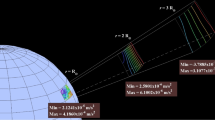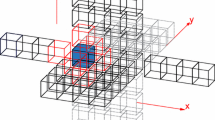Summary
In the light of the three geoscientific satellite missions CHAMP, GRACE and GOCE the overall scientific aim is to achieve an automatism for the recovery of the Earth’s gravity field respectively the physical shape of the Earth, namely the geoid. Furthermore, an improved understanding of the spatial and temporal variations of the geoid is of great benefit for the study of the dynamics of the Earth’s lithosphere and upper mantle, global sea level variations, ocean circulation and ocean mass and heat transport, ice mass balance, the global water cycle and the interaction of these phenomena. This involves the determination of up to a hundred thousand unknown coefficients of the corresponding series expansion model from data sets which amount to several millions of observations provided by the satellites. The resulting system of equations which has to be solved for such an analysis cannot be evaluated without simplistic assumptions or within a satisfying time frame on personal computers due to hardware limitations. Consequently this challenging problem has to be tackled by means of high performance computing strategies. Only adoption of parallel programming standards such as MPI or OpenMP in conjunction with highly efficient numerical libraries allows for successfully accomplishing the demands of gravity field analysis. Indeed, the huge amount of data provided by satellite sensors, together with a high-resolution gravity field modeling, requires the determination of several ten thousands of unknown parameters and leads to the assignment that this problem is a true “challenge of calculus”.
Access this chapter
Tax calculation will be finalised at checkout
Purchases are for personal use only
Preview
Unable to display preview. Download preview PDF.
Similar content being viewed by others
References
Baur, O., Austen, G.: A parallel iterative algorithm for large-scale problems of type potential field recovery from satellite data. Manuscript submitted to Advances in Geosciences (2005)
Benbow, S.J.: Solving generalized least squares problems with LSQR. SIAM J. Matrix Anal. Appl., 21, No. 1, 166–177 (1999)
European Space Agency (ESA): Gravity Field and steady-state ocean circulation mission. ESA Publications Division, Reports for Mission Selection of the four candidate earth explorer missions, ESA SP-1233(1), ESTEC, Noordwjik (1999)
GeoForschungZentrum Potsdam (GFZ): CHAMP-Der Blick in das Innere der Erde. GeoFoschungsZentrum, Potsdam (2000)
Hestenes, M.R., Stiefel, E.: Methods of conjugate gradients for solving linear systems, J. Res. Nat. Bur. Stand., 49, 409–436 (1952)
Jacobsen, M., Hansen, P.C., Saunders, M.A.: Subspace preconditioned LSQR for discrete ill-posed problems. BIT Numerical Mathematics, 43, 975–989 (2003)
Jet Propulsion Laboratory (JPL): GRACE science and mission requirements document. 327–200, Rev. B, Jet Propulsion Laboratoty, Pasadena, CA (1999)
Paige, C.C., Saunders, M.A.: LSQR: An algorithm for sparse linear equations and sparse least squares. ACM Transactions on Mathematical Software, 8, 43–71 (1982)
Paige, C.C., Saunders, M.A.: LSQR: Sparse linear equations and least squares problems. ACM Transactions on Mathematical Software, 8, 195–209 (1982)
Reubelt, T., Austen, G., Grafarend, E.W.: Harmonic analysis of the Earth’s gravitational field by means of semi-continuous ephemeris of a Low Earth Orbiting GPS-tracked satellite. Case study: CHAMP. Journal of Geodesy, 77, 257–278 (2003)
Author information
Authors and Affiliations
Editor information
Editors and Affiliations
Rights and permissions
Copyright information
© 2006 Springer-Verlag Berlin Heidelberg
About this paper
Cite this paper
Austen, G., Baur, O., Keller, W. (2006). Use of High Performance Computing in Gravity Field Research. In: Nagel, W.E., Resch, M., Jäger, W. (eds) High Performance Computing in Science and Engineering’ 05. Springer, Berlin, Heidelberg. https://doi.org/10.1007/3-540-29064-8_24
Download citation
DOI: https://doi.org/10.1007/3-540-29064-8_24
Publisher Name: Springer, Berlin, Heidelberg
Print ISBN: 978-3-540-28377-5
Online ISBN: 978-3-540-29064-3
eBook Packages: Mathematics and StatisticsMathematics and Statistics (R0)




